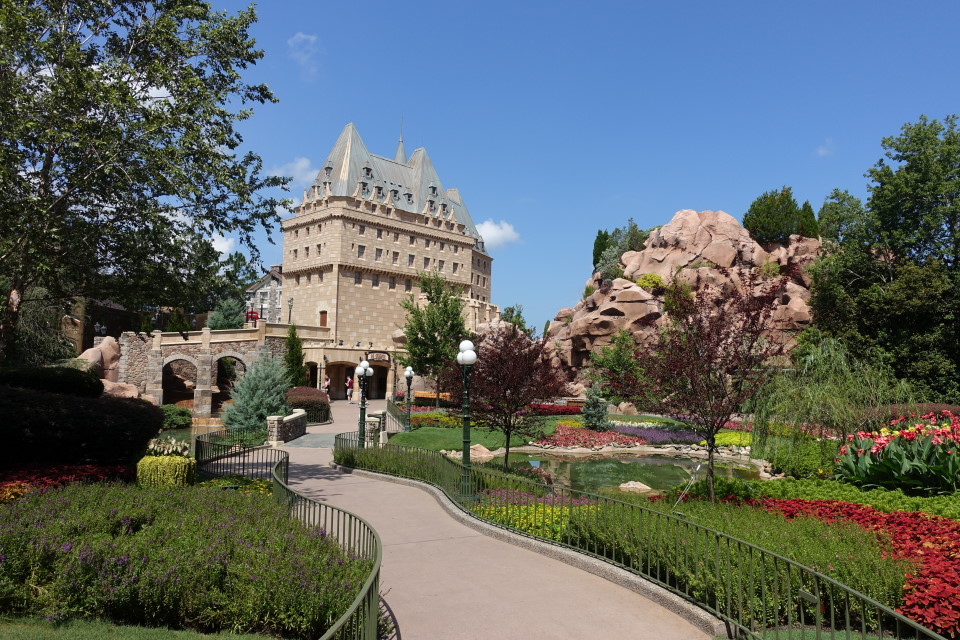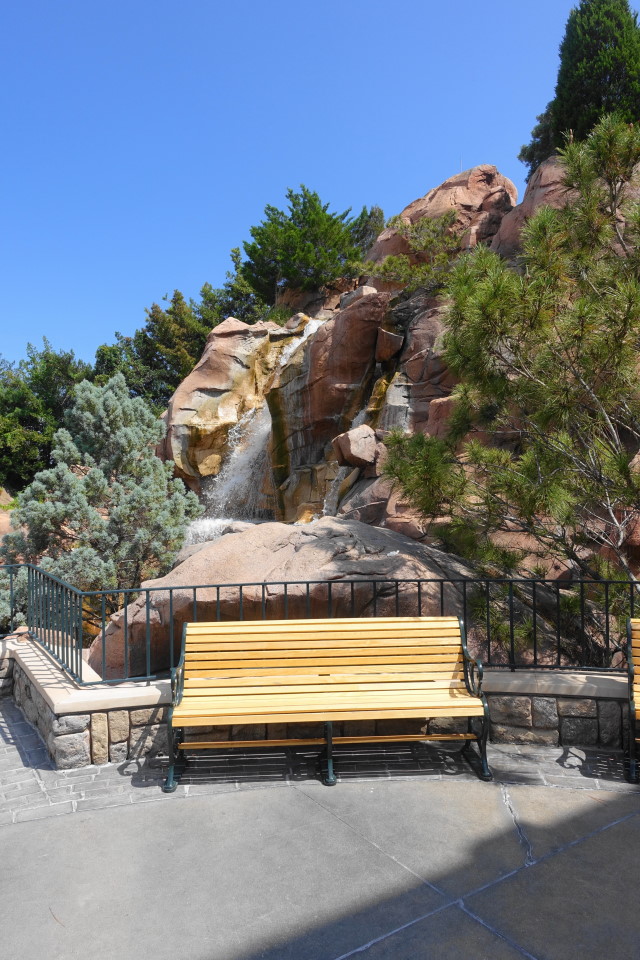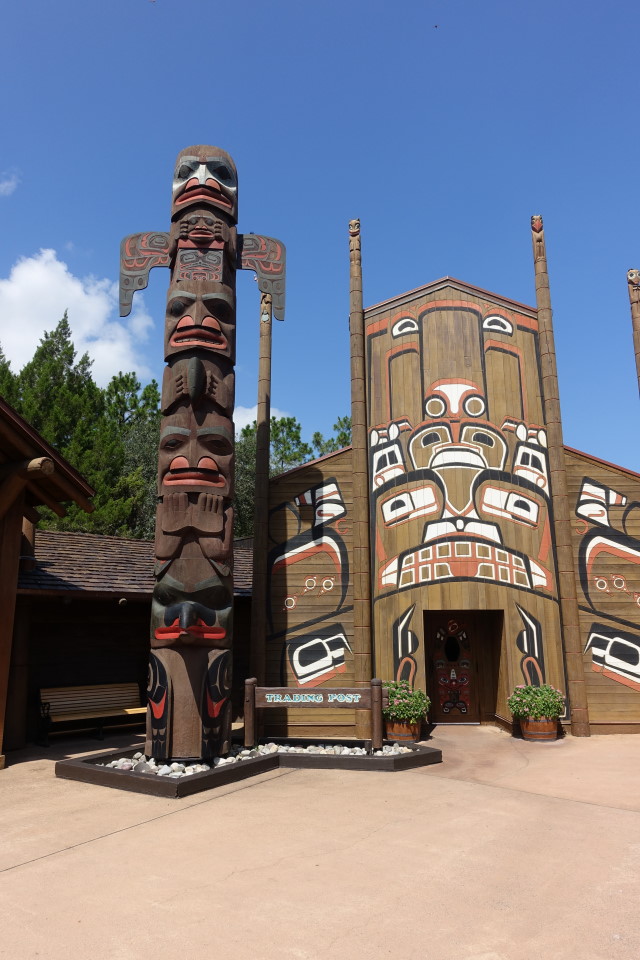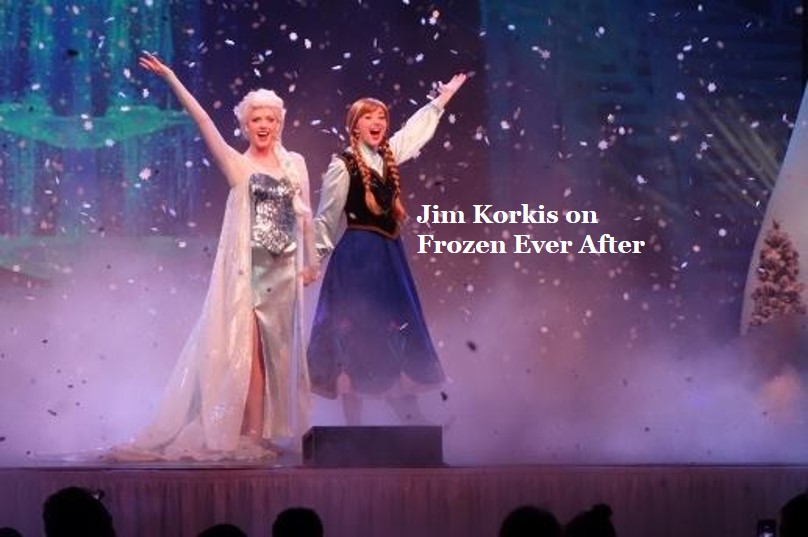Category — A Friday Visit with Jim Korkis
A Friday Visit with Jim Korkis: The Canada Pavilion at Epcot
Welcome back to Fridays with Jim Korkis! Jim, the dean of Disney historians and author of Jim’s Gems in The easy Guide, writes about Walt Disney World history every Friday on yourfirstvisit.net.
THE CANADA PAVILION AT EPCOT
By Jim Korkis
There were three fiberglass totem poles in the Canada Pavilion at Epcot when it opened in 1982, but they were merely decorative and intended to broadly represent the art work of the Indian tribes of the Northwest.
Two of the poles were located in the landscaping opposite the main merchandise shop. The Northwest Mercantile was meant to represent the frontiersmen, trappers, prospectors, loggers and traders who inhabited the area during the earliest years of the country. These individuals were both French and English.
The outside of the building is decorated with authentic tools and snowshoes from the Canadian wilderness that were found by the Imagineers during their explorations. Part of the same building is the Trading Post meant to reference the Canadian Indian culture.
The Maritime Provinces of Prince Edward Island, Nova Scotia and New Brunswick are represented by the stone work on the level with shops above the trading post. On the left hand side, the architecture references the British influence (and was intended to house the never installed Canadian Tourism Center offices) and on the right hand side, the French influence.
The Hotel du Canada is patterned after the Chateau Laurier in Ottawa and the Hotel du Frontenac in Quebec. This French gothic design is reminiscent of the hotels that were built during the expansion of the Canadian railroad system.
The hotel building may look six to seven stories tall but is only three stories tall due to the use of forced perspective, with the bricks and windows (appropriately decorated with scaled down items) growing progressively smaller as the building rises.
Just beyond the hotel is some of the last work done by legendary Imagineer Fred Joerger to re-create a sense of the Canadian Rockies. Imagineers flew over the Canadian mountains and took pictures to develop a topographical map. They then created a Styrofoam model and used a computer to draw a three-dimensional picture showing horizontal and vertical features as well as depth.
An enlarged version was adapted and used as the master blueprint for the steel structure which was then covered with Gunite, the same cement used in swimming pool construction. Joerger and his crew then textured it all by hand including the thirty foot tall waterfall.
The challenge was having live trees in an artificial environment which was solved by using a containerized plant system where trees were planted in five foot deep planters with built-in irrigation and drainage systems. This also proved useful when the trees started to grow too large for the appropriate forced perspective and could be easily replaced.
In 1998, the Disney Company employed Tsimshian artist David Boxley from Alaska, noted for his decades-long creation of totem poles, to carve an authentic 30-foot totem pole to replace the one near the trading post.
During the carving process, the seven hundred pound red cedar log was laid on its side on a raised platform in front of the pavilion. Boxley laboriously worked on it and interacted with the guests until it was erected next to the Trading Post on April 1998.
This beautiful totem pole tells the tale from the Pacific Northwest Indians of Raven and Sky Chief. When the Trickster Raven came to earth, the people lived in the dark without shadows and without the sun, moon, or stars. Raven began a search for light. He noticed Sky Chief kept a bright light in his home hidden away in a box.
Raven transformed himself into a pine needle that floats into a stream just as the Sky Chief’s daughter is taking a drink. She unsuspectingly swallows that needle and Raven becomes a baby in her stomach and is born to the delight of Sky Chief.
Sky Chief brings out the box to show his “grandson” the golden ball of light. Raven grabs the shiny ball, turns back into his true form and flies up into the sky where he tosses the light so all people can enjoy the sun, the moon and the stars.
This is a variation of the same Raven story told on the totem pole in the lobby of the Wilderness Lodge. Like the story of Snow White or Cinderella, it was a popular story with many different versions.
Boxley placed two small green Hidden Mickeys under each of the bending elbows near the top of the pole.
* * * * *
Thanks, Jim! And come back next Friday for even more from Jim Korkis!
In the meantime, check out his books, including Secret Stories of Walt Disney World: Things You Never You Never Knew, which reprints much material first written for this site, and The Vault of Walt: Volume 4, and his contributions to The easy Guide to Your First Walt Disney World Visit, all published by Theme Park Press.
Follow yourfirstvisit.net on Facebook or Google+ or Twitter or Pinterest!!
July 15, 2016 No Comments
A Friday Visit with Jim Korkis: Mary Blair’s Mural at the Contemporary Resort
Welcome back to Fridays with Jim Korkis! Jim, the dean of Disney historians and author of Jim’s Gems in The easy Guide, writes about Walt Disney World history every Friday on yourfirstvisit.net.
MARY BLAIR’S PUEBLO VILLAGE MURAL AT DISNEY’S CONTEMPORARY RESORT
By Jim Korkis
An artistic treasure at Walt Disney World is a mural in the Contemporary Resort done by Disney Legend Mary Blair.
Blair started at the Disney Studio in 1940 and contributed her unique color and design work to films that included The Three Caballeros (1945), Song of the South (1946), Cinderella (1950), Alice in Wonderland (1951) Peter Pan (1953), and many more. In particular, she was perhaps best known for her design work on the “it’s a small world” attraction.
Her massive ninety-foot tall mural encircles the elevator shafts of the Contemporary Resort, each wall telling a different part of the story of the children, animals, flora and geology of the Grand Canyon. Blair called the mural the “Pueblo Village”.
In 1966, Walt Disney gave Mary the opportunity to work for the first time with fired clays and textural color by hiring her to produce a 220 square foot ceramic mural for the Jules Stein Eye Institute at the UCLA Center for Health Services in Los Angeles.
Very pleased with the result, Walt then assigned her to produce two facing murals for the renovation of Disneyland’s Tomorrowland promenade that opened in 1967. They were each fifteen and a half feet high and fifty-four feet long and again featured her familiar children enjoying the future.
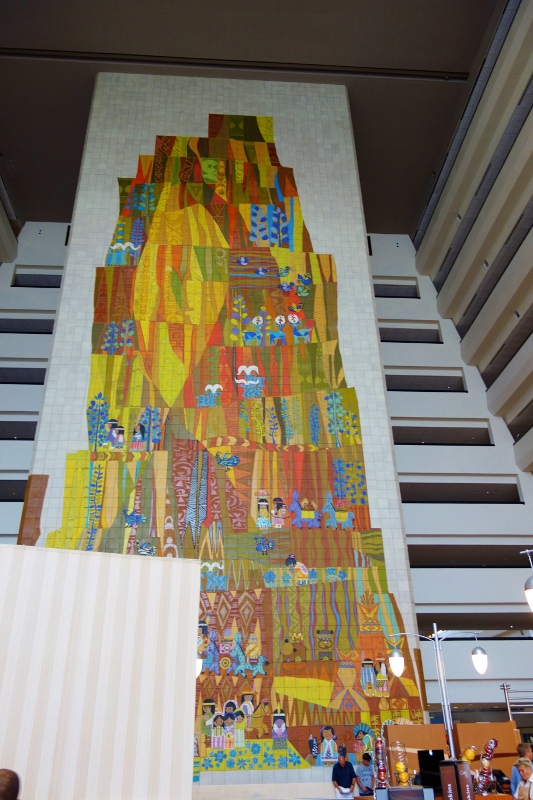
The architect Welton Becket, originally planned for the shafts to be encased in shiny metal, to capture a modern feeling.
Instead, Blair devised a more welcoming feel for the huge interior that was named the Grand Canyon Concourse. In 1971, the restaurants and bars in the hotel had related names like the Grand Canyon Terrace Café, El Pueblo Room, Mesa Grande Lounge and Outer Rim to suggest that natural wonder.
Each balcony was painted a different shade of earth tone to suggest the different layers of the canyon. It took eighteen months to design, produce and install the final mural that “hid” the elevators.
Blair was inspired by prehistoric petroglyphs, pueblo murals, Navajo ceremonial art and sand paintings. The colors were meant not just to suggest Native American art but earth and sky tones associated with the Grand Canyon.
Near the upper right of the mural that faces the monorail is a five-legged goat while all the other goats clearly have four legs. In their art, the Navajo have the concept of “purposely imperfect” to indicate that nothing man makes should be perfect because doing so would be an affront to the Great Spirit.
Blair used over 18,000 individually hand-painted, fire-glazed, one foot square ceramic tiles. High quality prints of her original design paintings for individual scenes were reproduced, framed and hung throughout the hotel, sometimes over the beds in each room. The prints were removed when the resort underwent a renovation in the early 1990s.
There is a photo of Blair looking over the layout of the tiles that were laid out on large tables in sections at WED in California. The tiles were shipped from California to Florida on special air-suspension trucks. When she saw the finished mural in Florida, she told writer Ross Care, “I walked into that giant concourse. My reaction was ‘Oh, wow!’”
* * * * *
Thanks, Jim! And come back next Friday for even more from Jim Korkis!
In the meantime, check out his books, including Secret Stories of Walt Disney World: Things You Never You Never Knew, which reprints much material first written for this site, and The Vault of Walt: Volume 4, and his contributions to The easy Guide to Your First Walt Disney World Visit, all published by Theme Park Press.
Follow yourfirstvisit.net on Facebook or Google+ or Twitter or Pinterest!!
July 8, 2016 No Comments
A Friday Visit with Jim Korkis: Snow White, Off the Beaten Path
Welcome back to Fridays with Jim Korkis! Jim, the dean of Disney historians and author of Jim’s Gems in The easy Guide, writes about Walt Disney World history every Friday on yourfirstvisit.net.
SNOW WHITE AT THE GAMBLE HOUSE
By Jim Korkis
Some Disney treasures are not on Disney property. Here is a secret that is not found in any other Disney travel guide or website.
In the deep forest of eastern Volusia County alongside the dark waters of Spruce Creek is a charming cottage of fantasy architecture known as the Snow White House that is virtually unknown to Disney fans. It is located off Taylor Road, roughly two miles west of I-95.
The tiny cypress-and-pine home is furnished with a miniature stairway that leads to a mock dwarfs’ bedroom marked by seven little headboards. Bookshelves set atop cypress knees and gnarled wood handles adorn the Gothic wood doors.
Surrounding the house are fantasy features such as a Witch’s Hut, dwarfs’ mine shaft and wishing well, all connected by field-stone paths.
Snow White and the Seven Dwarfs (1937) was a milestone animated feature film that captured the hearts and imagination of many people when it was first released.
Judge Alfred K. Nippert began building the Snow White House as a playhouse in 1938 for his nieces on the 150-acre hunting and fishing retreat that he inherited from his father-in-law, James N. Gamble, of Procter and Gamble.
The Gamble estate includes acres of forest, a Cracker-style lodge, a citrus packing house, azalea garden and trails through a hardwood swamp. It was donated in 1983 to the Nature Conservancy and is a historical and environmental preserve open to the public for tours by reservation.
The Daytona Beach Museum manages the Gamble place for the Conservancy with financial help from the Junior League of Daytona Beach. Tours of Gamble Place are arranged by appointment only through the Daytona Beach Museum of Arts and Sciences, (904) 255-0285.
Like so many others, the young girls loved Snow White and Nippert got carried away once the project started.
Nippert hired local carpenter Ernie Whidmeir, who prepared himself for the task by studying twenty animation cells from the film obtained from the Disney Studio and by repeatedly viewing the movie.
Because of Nippert’s social connections including supposedly a friendship with Walt Disney himself, he was able to obtain the celluloids for the carpenter to use as an architectural guide and create workable blueprints. A nearly full-scale replica was completed with heavy Gothic doors featuring huge authentic strap hinges and an enormous fireplace.
The cottage was completed in March 1938. Nippert invited Walt Disney to visit, and reportedly, he did.
Walt was so pleased and amazed at the detailed work that captured the fairy-tale quaintness of the film that upon his return to California, he gifted Nippert with eight life-sized dolls of Snow White and each of the Seven Dwarfs.
Snow White was displayed in the parlor in a glass coffin that Nippert had built to look like the crystal tomb in the movie. The seven Dwarf dolls were put in various corners of the room to keep a watchful eye on the sleeping little princess as they awaited the arrival of the prince and true love’s kiss.
But the dolls disappeared between the time the Nippert family closed the estate in the 1940s and the Nature Conservancy took it over in the early 1980s.
During a restoration in the early 1990s, Dana Ste. Claire and his wife, Carol, lived in the Snow White House for two years, working in their free time to restore the landmark and have furnished it with their own antiques. After they finished, they moved out.
”We’re going to try to get the Disney folks interested in this . . . they might come over a do a little film about the house,” Dana Ste. Claire said at the time but that never happened and this little gem has been hidden from Disney fans for many years
Except for special events open to the public, tours of Gamble Place are arranged by appointment only through the Daytona Beach Museum of Arts and Sciences, (904) 255-0285. So the next time you decide to go “off property” to explore some of the many other offerings of Central Florida, you may want to include this little known Disney related treasure.
* * * * *
Thanks, Jim! And come back next Friday for even more from Jim Korkis!
In the meantime, check out his books, including Secret Stories of Walt Disney World: Things You Never You Never Knew, which reprints much material first written for this site, and The Vault of Walt: Volume 4, and his contributions to The easy Guide to Your First Walt Disney World Visit, all published by Theme Park Press.
Follow yourfirstvisit.net on Facebook or Google+ or Twitter or Pinterest!!
July 1, 2016 No Comments
A Friday Visit with Jim Korkis: Hidden Joe Rohdes
Welcome back to Fridays with Jim Korkis! Jim, the dean of Disney historians and author of Jim’s Gems in The easy Guide, writes about Walt Disney World history every Friday on yourfirstvisit.net.
JOE ROHDE AT WALT DISNEY WORLD
By Jim Korkis
Disney guests are quite fond of locating Hidden Mickeys, usually three circles that seem to resemble the face front silhouette of Mickey Mouse. There are other more clever variations including Mickey’s foot peeking out at the bottom of a poster in the Great Movie Ride.
Some Disney guests are so observant that they spot the names of people who worked on the parks, often hidden on props like crates, signs and barrels. Near the Jungle Cruise at the Magic Kingdom, there are references to Disney Legends Bill Evans, Wathel Rogers, Winston Hibler, and Harper Goff among others.
When Disney’s Animal Kingdom opened, there were hidden references to various Imagineers throughout the park. The Shields hot air balloon trips refer to landscape planner John Shields. The architectural restoration company Mjafari is a shout-out to architect Ahmad Jafari.
However, as might be suspected, the most prominent name found throughout the park is that of Joe Rohde, who was the Imagineering executive designer and creative director for the project.
Rohde joined Imagineering in 1980 during the development of Epcot, contributing specifically to the Mexico pavilion. He was later significantly involved in other projects inlcudng among others the Adventurers Club on Pleasure Island, Disney Vacation Club Aulani Resort and the Norway Pavilion.
Rohde commented in 2008 at the park’s tenth anniversary celebration:
“My favorite memory of designing Disney’s Animal Kingdom was walking and riding my bike in the African savanna in the days before we put the African animals in. The whole environment was completed and fully grown in. It went on forever and really looked, even smelled like Africa.
“There were thousands of frogs in the evening, and by day there were huge flocks of little grey doves that would burst out of the grass when I walked by. Sometimes after work, I would just walk out and sit in the grass and it would be perfectly quiet.
“My favorite parts of the park are the big savanna views of Kilimanjaro Safaris, the quieter parts of Maharajah Jungle Trek and the Expedition Everest queue line.
“My favorite memory of opening day was when Jane Goodall thanked all of us Imagineers for all of our dedication and hard work. The most unique contribution of DAK is the ongoing conservation program. This puts the idea of love of animals into real action in the real world.”
Many advertisements in Harambe village are for Jorodi Masks & Beads. The name “Jorodi” is pronounced “Joe Rohde”. Rohde supplied many exotic masks for the now defunct Adventurers Club.
Rohde would laugh that he traveled the world looking for artifacts for the club but couldn’t find any that he felt would work so that all the Adventurers Club artifacts like masks were obtained at swap meets in the Pasadena, California area.
In the Adventurer’s Club main show room, the crooked picture on the side of the stage had a caricature of Rohde as an adventurer in the right hand side of the picture. It was just one of several Rohde references in the club.
The actual storefront for Jorodi Masks & Beads business is hidden away on the second floor of the main room of the Animal Kingdom’s Tusker House, over the hallway leading to the restaurant’s restrooms. A sign there emphasizes the business specialized in earrings, a reference to the distinctively huge ones Rohde wears on his left ear that he gathered on his many travels.
The final sign in the queue for Expedition Everest states “The Yeti Museum gratefully acknowledges the following individuals and organizations for their contributions of photographic material”. Halfway down the second column on the left is the name Joe Rohde.
The signs for Cap’n Bob’s Super Safaris in hot air balloon feature a cartoon caricature of Bob that looks very much like Rohde.
So Rohde’s presence is everywhere in the park he designed, and maybe in some areas yet to be discovered by curious explorers.
* * * * *
Thanks, Jim! I walked behind Joe Rohde’s ear in April at Disney’s Animal Kingdom Lodge!
And come back next Friday for even more from Jim Korkis!
In the meantime, check out his books, including Secret Stories of Walt Disney World: Things You Never You Never Knew, which reprints much material first written for this site, and The Vault of Walt: Volume 4, and his contributions to The easy Guide to Your First Walt Disney World Visit, all published by Theme Park Press.
Follow yourfirstvisit.net on Facebook or Google+ or Twitter or Pinterest!!
June 24, 2016 No Comments
A Friday Visit with Jim Korkis: Frozen Ever After and Norway
Welcome back to Fridays with Jim Korkis! Jim, the dean of Disney historians and author of Jim’s Gems in The easy Guide, writes about Walt Disney World history every Friday on yourfirstvisit.net.
FROZEN EVER AFTER AND EPCOT’S NORWAY PAVILION
By Jim Korkis
On September 12, 2014, Disney announced the Maelstrom attraction would be closed on and renovated as a new attraction called Frozen Ever After.
Queen Elsa, Princess Anna, Kristoff, Olaf, trolls and Marshmallow (the giant snowman) join guests on their boat journey on a “summer snow day” through the frozen willow forest, past Troll Valley and up to the North Mountain to Elsa’s ice palace. The attraction ends in the Bay of Arendelle.
Along the way, state-of-the-art audio-animatronics including Sven the reindeer are in the new scenes as well as elements from the animated short Frozen Fever (2015) including the Snowgies, the mini-snow creatures created from Elsa’s sneezes.
Composers Bobby Lopez and Kristen Anderson-Lopez created new lyrics to the original Frozen (2013) film songs they wrote, and all of the original voice talent from the film returned and recorded new dialogue and songs for the attraction.
“The original animated film was heavily influenced by Norwegian culture and the filmmakers conducted extensive research in Norway,” stated Imagineer Wyatt Winter who worked on the new attraction. “Our team began our process in the same manner, visiting places in Norway that heavily influenced our work. While there’s clearly a Frozen twist to our story, honoring the culture and traditions of Norway was always among our guiding principles.”
The official dedication of the Norway Pavilion was on Friday June 3, 1988 but because of glitches in its feature attraction (including drenching passengers in the North Sea scene), Maelstrom itself did not open until about a month later on July 5th.
An Epcot press release at the time described the attraction: “Visitors take a fantasy voyage that departs a modern-day village on a Norwegian fjord and journeys up a cascading waterway into the Norway of old. The trip is aboard small ships patterned after the dragon-headed craft of Eric the Red and his fellow explorers.”
The boats were some of the first concept art work done by Imagineer Joe Rohde for Walt Disney World. It was also some of the last work done by famed Imagineer Jack Ferges who built the model for the ride vehicle ship which was replicated in fiberglass copies used in the attraction.
Originally, the attraction was to be called “SeaVenture” and the concept was more mythological in tone. Guests would be riding along a 946 foot water flume encountering trolls and gnomes and the legends about them. Another proposal was Vikings on their way to the Rainbow Bridge to Vallhalla.
The Norwegian sponsors (NorShow) disliked the concept and wanted the attraction to be more of a travelogue to encourage increased tourism.
NorShow gave the Imagineers a list of items they wanted shown in the attraction that they felt uniquely related to the story of Norway including Vikings, a fishing village, a polar bear, a fjord, an oil rig and perhaps, if there was room, a troll or two.
Attraction Designer Bob Kurzweil came up with the new approach– that it would be a time travel experience through the history of Norway beginning with the earliest folklore and ending in modern day Norway to incorporate everything that the sponsors wanted.
In the first full year of operations over 5.7 million guests rode the popular Maelstrom attraction.
NorShow sold back its interest in the pavilion at a loss to Disney in 1992 but the Norwegian government continued to support the pavilion with a contribution of $200,000 a year for the next ten years. However they dropped all financial support in 2002.
Becoming the sole support of the pavilion, the Disney Company looked for a way to increase revenue and attendance. The unexpected success of the movie Frozen (2013) followed by the over four hour wait by guests to meet Elsa and Anna in the pavilion spurred the idea of an animation overlay similar to the ones done for the Mexico and Living Seas attractions.
* * * * *
Thanks, Jim! And come back next Friday for even more from Jim Korkis!
In the meantime, check out his books, including Secret Stories of Walt Disney World: Things You Never You Never Knew, which reprints much material first written for this site, and The Vault of Walt: Volume 4, and his contributions to The easy Guide to Your First Walt Disney World Visit, all published by Theme Park Press.
Follow yourfirstvisit.net on Facebook or Google+ or Twitter or Pinterest!!
June 17, 2016 No Comments
A Friday Visit with Jim Korkis: Disney’s Grand Floridian Resort
Welcome back to Fridays with Jim Korkis! Jim, the dean of Disney historians and author of Jim’s Gems in The easy Guide, writes about Walt Disney World history every Friday on yourfirstvisit.net.
THE OPENING OF DISNEY’S GRAND FLORIDIAN RESORT IN 1988
By Jim Korkis
“Journey back to the turn-of-the century…to another time and another place. The Grand Floridian Beach Resort. An oasis of elegance that’s the first of its kind since the golden age of pleasure travel. Bright white towers and gabled roofs echo the Victorian architectural influence that has come to symbolize Florida’s carefree winters and balmy summer nights,” proclaimed newspaper advertisements in the summer of 1988.
Disney held a special press event June 23-26 that brought in 1,400 members of the media to celebrate the latest additions to Walt Disney World including Mickey’s Birthdayland, the Norway pavilion’s Maelstrom attraction, Mickey’s 60th birthday and new productions at Disney MGM Studios (Now Disney’s Hollywood Studios).
In addition, it was the official dedication of the Grand Floridian Resort that opened July 1, 1988. CEO Michael Eisner and actor Burt Reynolds, who then lived in Florida, cut the ceremonial ribbon stretched between two palm trees to open the Grand Floridian.
An orchestra played the song “That’s Entertainment”. An aquatic ballet was performed in the 275,000 gallon pool. Singers and dancers performed a medley of turn-of-the-century tunes.
Burt was honored by Disney as a “grand” Floridian at a gala dinner that night. Reynolds attended Florida State University on a football scholarship. He owned a 160-acre estate in Florida, dubbed Burt’s Ranch, transforming it into a film studio where scenes for Smokey And The Bandit (1977) were filmed as well as operating a dinner theater in Jupiter, Florida.
Burt was actually in the area to tape a segment of the game show that he co-produced, Win, Lose or Draw, which was filmed at Disney MGM Studios.
The Grand Floridian was inspired by the Victorian era beach resorts built along Florida’s east coast during the late 19th century and early 20th century when wealthy and famous people from the north would travel by train to warmer climes.
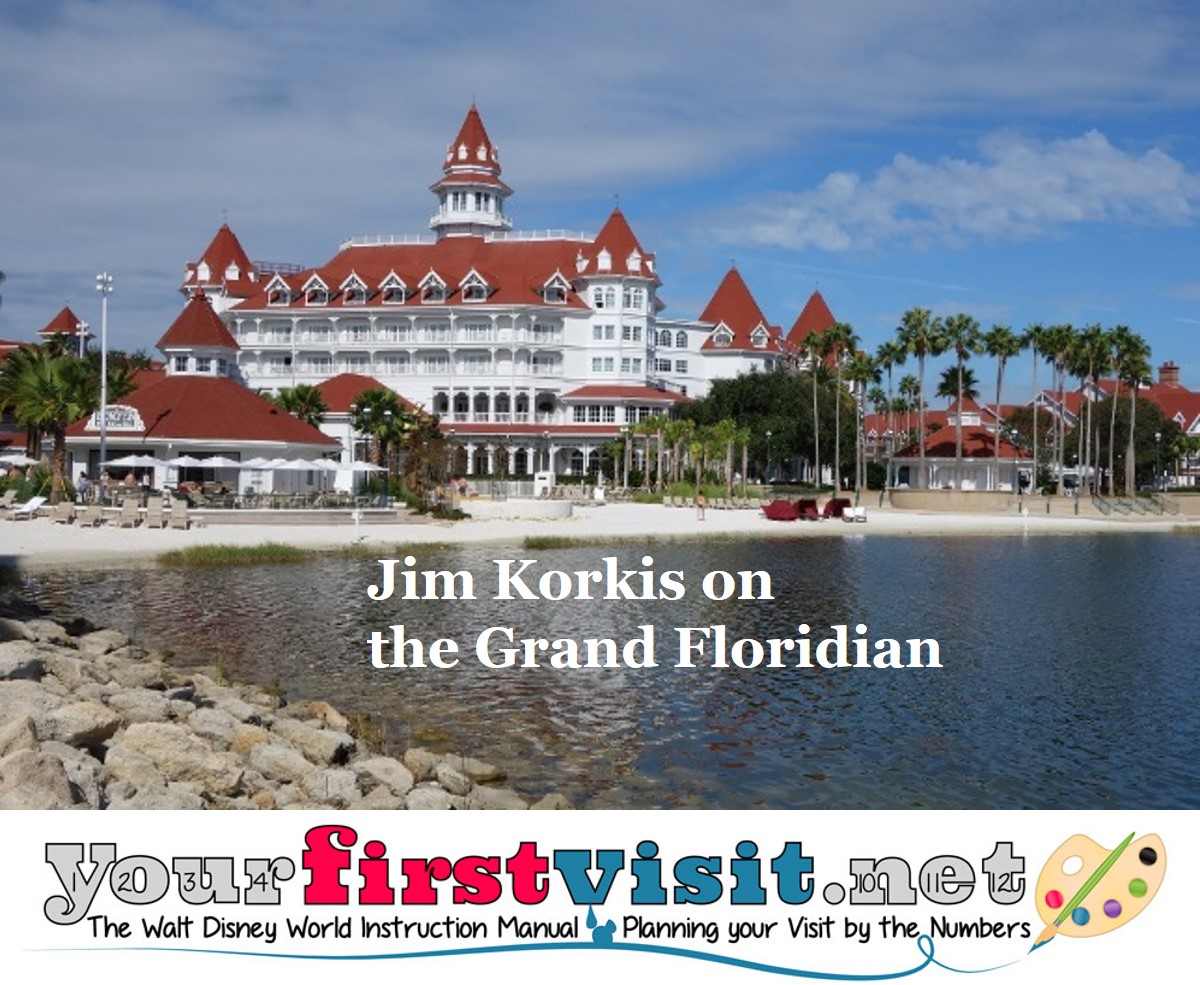
The Belleview Hotel, as it was initially known, was constructed by railroad tycoon Henry B. Plant in 1897 as a resort destination to boost tourist travel on his railroad line serving the west coast of Florida, which he had acquired in 1893. The hotel closed in 2009 and was demolished in 2015.
The name of the second floor bar Mizner’s Lounge’s comes from Addison Mizner, an architect who specialized in “Gatsby-esque” mansions in Palm Beach and Boca Raton.
The architecture of the Grand Floridian is a collage of American, English, French and Caribbean. Rather than a historically accurate Victorian color theme that would have been too dark and somber for this playful seaside resort, the Imagineers selected soft greens, blues and peaches.
Of particular interest, 1900 Park Fare restaurant features Big Bertha, an antique band organ built in Paris, France by Gavoli & Co at the turn-of-the century, which is installed in a wall fifteen feet above the guests. It plays music utilizing simultaneously the instruments of pipes, drums, castanets, bells, cymbals, and xylophone played originally by paper piano-roll “books”.
The organ was used from 1909 to 1955 in Ramona Park, an amusement park in Grand Rapids, Michigan known as the “Amusement Mecca of Western Michigan.” The park was demolished in 1955 and the three antique band organs used for the merry-go-round went into storage in Alabama for many years where they were discovered in 1963 and restored.
The Grand Floridian Resort and Spa is a showcase of amazing details from the Chinese-style aviary in the lobby that was crafted in Spain to the vintage Victorian piano in the Lobby obtained from an estate in Georgia to the entrance of Victoria & Albert’s that features eleven original maps of Florida dated from 1775 up to the period of railroad tycoon Henry M. Flagler’s railway lines in the late 1880s.
* * * * *
Thanks, Jim! I’ll be re-visiting the Grand Floridian and also the Villas there in my August/September trip! And come back next Friday for even more from Jim Korkis!
In the meantime, check out his books, including Secret Stories of Walt Disney World: Things You Never You Never Knew, which reprints much material first written for this site, and The Vault of Walt: Volume 4, and his contributions to The easy Guide to Your First Walt Disney World Visit, all published by Theme Park Press.
Follow yourfirstvisit.net on Facebook or Google+ or Twitter or Pinterest!!
June 10, 2016 No Comments

